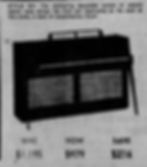Baldwin's Mid Century Piano: A nod to Danish Modernism
- Tim Hills
- Feb 22, 2021
- 3 min read
Updated: Apr 4, 2023
Perhaps the only well known mid century modern piano is the Baldwin Acrosonic pictured below. It is highly sought-after and consistently commands a high price when available. Read on to learn who designed it, what probably influenced it and how much it originally cost.

With its Danish modern inspired lines, oiled walnut case and delicate cane panels it captures the modern attitude of the time perfectly. It even comes with a stool with legs that match the angles on the piano. For an instrument that is otherwise becoming less popular due to the limitations of space and the hassle of moving such a heavy piece of furniture, the Acrosonic is a bit of a unicorn.
Designer
The designer of the cabinetry of this iconic instrument was most likely William Millingham, an English designer who moved to the USA at the age of 30. After working for a number of firms and acting as a representative of the US Chamber of Commerce at the Paris Exposition of 1925 in Paris, Millington joined Baker Furniture the following year. He would stay there until his death in 1963.

William Millington Source
Baker is arguably the only American company to produce a high profile line of furniture by a Danish Master, Finn Juhl. It's little surprise then that the designer behind the piano had a connection to Scandinavian modernism.
Influence
The line known as Baker Modern launched in 1952 and showcased the Dane's stripped down yet elegant forms with bold curves and seat shapes inspired by African shields. Legs were set off with two tone tips of a different wood, much of the line was offered in oiled walnut and a few pieces incorporated cane to add yet another texture. The article shown below is from House and Garden magazine 1952 when the collection launched.
While the piano would never be mistaken for a Finn Juhl design, it is not a stretch to say Millington took some cues from the line he was probably involved with in some capacity 8 years earlier. The clean lines, splayed front legs, brass capped feet, warm natural walnut and the cane panels all echo the essence of the Baker Modern line. The cane fronted credenza below is perhaps most obvious transposition of Finn Juhl's sensibilities :


Launch
Pianos were big business in the mid century - post war production of Baldwin pianos was double that of pre war by 1953. Released in early 1960, this particular piano was marketed as the 'Scandinavian Natural Walnut 947 Acrosonic' and the link to Baker was either hinted at or clearly made.

(Source: The Boston Globe, Wed, Feb_24, 1960)
The piano was such an eye catcher it was touted in the ad below for its double duty as a room divider, reaching for Hans Wegner's (another Danish master) goal that 'A chair should have no back side. It should be beautiful from all sides and angles'

(Source: Hartford Courant, Sun, Nov 20,1960)
Attribution
The ad below from 1959 shows a range of Acrosonic styles including Modern and Millington is noted as the designer in the paragraph above. Historically, his is the only designer named in connection to the Acrosonic range. The Scandinavian model would come out the following year.

(Source:The Miami Herald, Sun Oct 4, 1959)
The ad below carries the line 'Acrosonic Styling is the creation of William Millington, nationally noted stylist and designer of Baker Furniture'

(Source: The Baltimore Sun, Sun Feb 8, 1959)
The Baker Modern styling, components and possible manufacturing make the attribution even more likely. Though he was more known for traditional styling, Baldwin's development of a wide range of Acrosonic cabinet styles meant that a Scandinavian modern piano was almost inevitable. As Millington died in 1963, it is interesting to note that this may have been one of his last designs.


(Source: The Boston Globe Sun, Sep 20, 1959)
This ad from 1960 includes the phrase 'It is the Acrosonic, built by Baldwin, encased in cabinetry designed and hand crafted by Baker Furniture Inc. The wood, American Walnut has been fashioned by Baker craftsmen...' Whether the ommission of Millington's name is significant or merely due to text limitations of a smaller ad is not clear.

(Source: The Post Standard Sun, May 22, 1960)
Price
This stylish piano cost an amazing $1199 when first launched. That is the equivalent of over $10500 dollars in today's money!

(Source: The Sacramento Bee, Mon, May 23, 1960)
We do get these beautiful pianos in from time to time so send do us a message so we can add you to our list.
Sources:
Check out some of our other blogs on mid century modern furniture design:

























